NCERT Summary: Terms, Concepts and their Use in Sociology (Class 11) | Old & New NCERTs for IAS Preparation (Must Read) - UPSC PDF Download
Significance of Terms and Concepts in Sociology
We need specific terms and concepts to understand our divergent views about how and why society exists.

- The terms and concepts reflect the concern of social thinkers to understand and map the social changes.
- It reflects the concern that sociologists had in understanding the structured inequalities between groups and society.
- Some approaches start with the individual to understand behavior, focusing on micro interactions, while others examine macro structures like class, caste, market, state, or community. Status and role focus on the individual, whereas social control and stratification look at the broader context in which individuals exist.
- Terms and concepts act as tools of different ways to understand society.
- Sociology as a discipline allows the coexistence of concepts that leads to divergence of views. For example, conflict theory versus functionalist theory. This multiplicity of approaches is particularly acute in sociology. Or, how different thinkers explain society and its functioning.
Social Groups and Society
Social group refers to a collection of continuously interacting persons who share common interest; cultures, values, and norms within a given society.
Characteristics of Social Group
- Persistent interaction to provide continuity
- A sense of belonging
- Shared interest
- Acceptance of common norms and values
- A definable structure.

Quasi Groups
A quasi group can be defined as an aggregate or combination, which lacks structure or organisation, and whose members may be unaware, or less aware, of the existence of groupings.
- Examples: Passengers waiting at a railway station or airport or bus stop or a cinema audience. Such aggregates are often termed as quasi groups.
- For example, social classes, status groups, age groups, gender groups can be quasi groups.
- In due course of time and in specific circumstances such aggregates might take the form of a social group as sociologically defined.
- For example, people belonging to the same caste might come together to form a caste based political party.
- Such political parties will be referred to as social groups as members will be conscious of their interaction and belonging.
Difference between Social Group Vs. Quasi Group
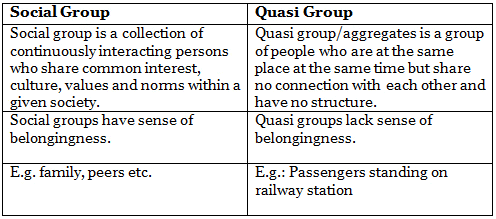 Difference between Social Group Vs. Quasi Group
Difference between Social Group Vs. Quasi Group
Types of Groups
Different sociologists have classified social groups differently. In their classifications, they take different criteria into account.
Primary and Secondary Group
- Primary Group and Secondary Group on basis of size/type of relationship
- It is the most well-known classification given by Cooley on the basis of size and type of relationship shared among its members.
- Primary group refers to small group of people connected by intimate and face-to-face association and co-operation, for e.g. family, village, and groups.
- Secondary group is the group in which there is a lack of intimacy, e.g., different political groups, economic associations etc.
 Difference between Primary and Secondary Group
Difference between Primary and Secondary Group
Characteristic of primary group
(1) Small size of group
(2) Physical proximity
(3) Continuity and stability of the relationship
(4) General responsibility
(5) Common-aim
Characteristic of secondary group
(1) Large size
(2) Indirect relationship
(3) Fulfilment of special interest
(4) Limited responsibility
(5) Impersonal relationship
Community and Society (or Associations)
Community:
- Definition: Community refers to close, personal relationships where people know each other well and care deeply for one another.
- Examples: Family, close friends, and tight-knit groups like local clubs or neighborhood associations.
Society (or Association):
- Definition: Society, or association, refers to more distant and formal relationships, often found in larger, modern settings where interactions are more about business or practical matters.
- Examples: Business contacts, coworkers, and people you meet in cities or large organizations
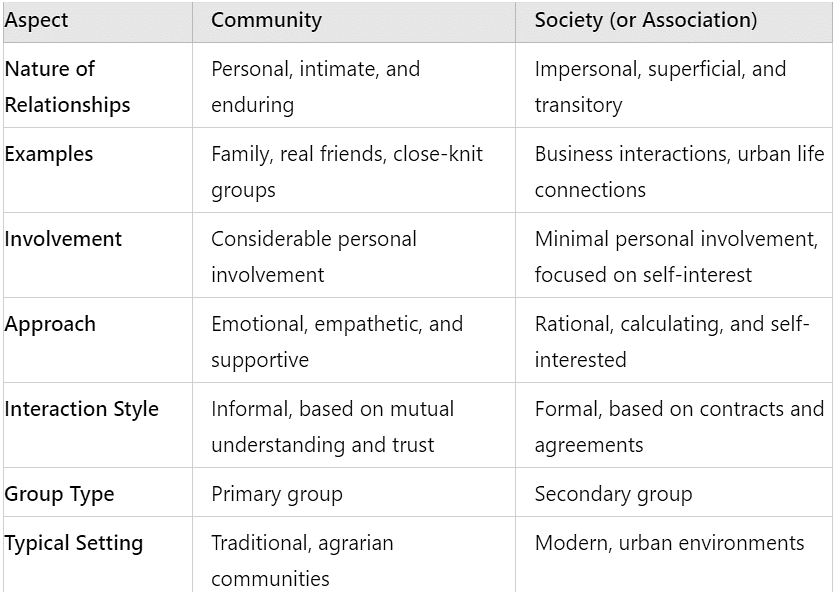
In Group and Out Group
Ingroups:
- Definition: Groups you feel you belong to and identify with.
- Example: Your group of close friends.
Outgroups:
- Definition: Groups you don't belong to and see as different.
- Example: A rival sports team.
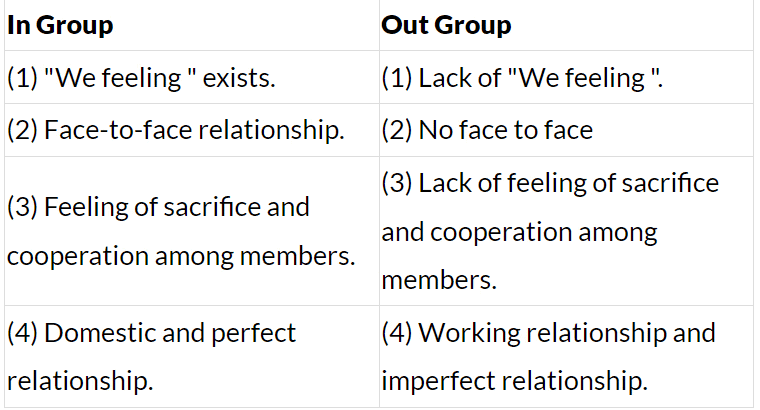 Difference between 'In Group' and 'Out Group'
Difference between 'In Group' and 'Out Group'
Reference Groups
There always exists a group that acts as a model for the individual or any group.
- This model group is treated as the reference group. For instance a person/individual copies or emulates the life of any film actor or artist.
- Aggregates of people who are in the same place at the same time but share no definite connection with one another are termed as 'quasi groups'.
Peer Groups
- Peer group is a sort of primary group where members come together to pursue a similar activity.
- Peer groups are usually of the same age.
- Classmates in a school, colleagues at office, co-participants in the aerobics classes, are all examples of peer groups.
Social Stratification
Social stratification refers to the structured inequalities between different groups in society regarding their access to material or symbolic rewards. It is essentially about the differences in power and advantage among various groups. Just as geological layers of rock show different levels of earth, society can be viewed as having different levels or 'strata' of people, with those at the top having more advantages than those at the bottom.
Impact of Stratification: Stratification affects every aspect of an individual's life, including opportunities for health, longevity, security, educational success, job satisfaction, and political influence. These opportunities are distributed unequally and systematically, highlighting the importance of understanding stratification in the organization of society.
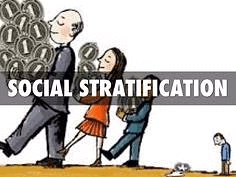
Forms of Social Stratification
Four basic systems of stratification have existed in human societies: slavery, caste, estate, and class.
1. Slavery
Slavery is the extreme form of inequality in which some individuals are literarily owned by others. The Greeks and Romans kept slaves as soldiers, servants, labourers, and even civil servants. The Romans captured slaves from present-day Britain, France and Germany. Slave armies were kept by the Ottomans and Egyptians. As formal institution slavery has at present been eradicated. However, there are still instances of its existence found in numerous forms in any corners of the world.
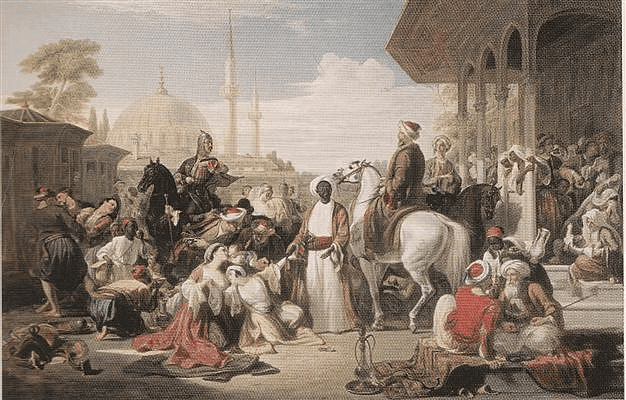 The Istanbul Slave Market
The Istanbul Slave Market
2. Caste and Class
| CASTE | CLASS |
| 1. It depends on birth. | It depends on social circumstances. |
| 2. It is a closed group. | If open group. |
| 3. There are rigid rules in marriage, eating — habits, etc | There is no rigidity, |
| 4. It is a permanent/stable organization. | It is less stable than the caste system. |
| 5. It acts as an obstacle to Democracy and Nationalism. | It does not create any obstacle to Democracy and Nationalism. |
(i) Caste as a System of Stratification
In a caste stratification system, a person's position is determined by status attributes ascribed by birth, rather than by achievements throughout life.Although class societies also impose limitations on achievement based on attributes like race and gender, in caste societies, birth ascribed attributes define an individual's position more completely.
Traditional Caste Hierarchy in India
- In traditional India, different castes were organized in a hierarchy based on purity and pollution concepts.
- The Brahmins, considered the most pure, were at the top of the hierarchy, while the Panchamas, or 'outcastes,' were at the bottom.
- The system is often described in terms of the four-fold varna—Brahmins, Kshatriyas, Vaishyas, and Shudras.
- However, in reality, there are many occupation-based caste groups known as jatis.
Changes in the Caste System
- The caste system in India has seen significant changes over time.
- Urbanization challenged traditional practices like endogamy(marrying within the caste) and ritual avoidance of contact with lower castes, which were crucial for maintaining purity among upper castes.
A.R. Desai’s Observations on Urbanization
- Sociologist A.R. Desai noted that urbanization brought about modern industries and cities filled with cosmopolitan establishments like hotels, restaurants, and theatres.
- These urban spaces became crowded with people from all castes and creeds.
- Public transport like trains and buses saw interactions among different caste members, including those from depressed classes.
- Despite these changes, caste did not disappear.
Caste Discrimination in Urban Settings
- While open discrimination might be less prevalent in urban settings like mills compared to villages,private interactions still reflect deep-seated caste biases.
- For instance, individuals from certain castes may refuse to accept water from others' hands or use abusive language, believing in their inherent superiority.
- Such attitudes persist regardless of how well the other person dresses.
Continuing Caste Discrimination and Democratic Changes
- Even today,acute caste discrimination remains a reality.
- However,democracy has influenced the caste system, with castes acting as interest groups and discriminated castes asserting their democratic rights.
(ii) Class as a System of Stratification
- Marx's Perspective on Social Class: Marxist theory defines social classes based on their relationship to the means of production. This involves determining whether groups own the means of production, such as land or factories, or if they only own their labor.
- Weber's Concept of Life Chances: Weber introduced the concept of life chances, which refers to the rewards and advantages individuals gain through market capacity. He argued that inequality could stem not only from economic relations but also from factors like prestige and political power.
- Functionalist Theory of Social Stratification: The functionalist perspective posits that no society is classless or unstratified. Social stratification is seen as a necessary mechanism for placing and motivating individuals within the social structure.
- Aim of Social Stratification: Functionalists believe that social inequality ensures that the most important positions are filled by the most qualified individuals. This process is seen as an unconscious evolution of society.
- Caste System vs. Class System: The traditional caste system is characterized by a fixed and rigid hierarchy transmitted across generations. In contrast, the modern class system is more open and based on achievement.
- Social Mobility in Democratic Societies: Democratic societies theoretically allow individuals from the most deprived classes and castes to reach the highest positions. While stories of achievement are inspiring, the class structure often persists.
- Sociological Studies of Social Mobility: Sociological research on social mobility, even in Western societies, reveals that ideal models of perfect mobility are rarely achieved. Studies highlight the ongoing challenges to the caste system and the persistence of discrimination.
- Disadvantages of Lower Levels in the System: Individuals at lower levels of the social system face not only social disadvantages but also significant economic challenges. This dual disadvantage impacts their opportunities for mobility and success
Status and Role
Understanding Status and Role in Society
- Status refers to a person's social position within a group or society, which comes with specific rights and responsibilities. For example, a mother has a status that includes various norms and duties.
- Role is the active aspect of a status, representing how individuals behave in that position. While status is something one holds, roles are something one performs. A status can be seen as a formalized role that is widely recognized and standardized in society.
- In modern societies, individuals often hold multiple statuses simultaneously, known as a status set. For instance, a student can be a child, a customer, a sibling, and a patient all at once.
- Status sequence refers to the order in which different statuses are acquired over a person's lifetime, such as becoming a son, then a father, and so on.
- Ascribed status is a position assigned at birth or involuntarily, often based on factors like age, caste, race, or family ties. Traditional societies tend to have more ascribed statuses.
- Achieved status is a position earned through personal efforts, achievements, or choices, such as educational qualifications or professional success. Modern societies often emphasize achieved statuses.
- Status and prestige are linked, as certain rights and values are associated with each status. Prestige refers to the value attached to a status, which can vary by society and time. For example, a doctor may have higher prestige than a shopkeeper, even if the doctor earns less.
- Role conflict occurs when the expectations of different roles linked to various statuses clash. For instance, a working woman may struggle to balance her roles as a mother, wife, and professional.
- Role stereotyping involves assigning specific roles to individuals based on societal norms, such as seeing men as breadwinners and women as homemakers. While social roles and statuses may seem fixed, they are subject to negotiation and change through social interaction.
- Socialization is the process by which individuals learn and internalize social roles, but it also allows for agency and the ability to challenge discriminatory roles based on factors like caste, race, or gender.
- Society relies on roles, statuses, and social control to function, with individuals actively shaping and sometimes resisting these roles.
Society and Social Control
- Social control is a key concept in sociology, referring to how society brings back its unruly members into line.
- Sociology has different perspectives on social control, with functionalists viewing it as necessary for stability and conflict theorists seeing it as a tool of the powerful.
- Functionalists believe social control helps maintain order and cohesion by restraining deviant behavior and managing conflicts.
- Conflict theorists view social control as a means for dominant classes to impose their will on others, with law serving the interests of the powerful.
- Social control can be formal(like laws and state actions) or informal(like smiles, frowns, and criticism).
- Formal social control involves codified and systematic methods, with agencies like law and state playing a major role.
- Informal social control is personal and unofficial, involving family, religion, and kinship.
- Sanctions are used to reinforce expected behavior, with positive sanctions rewarding good behavior and negative sanctions punishing deviance.
- Deviance refers to actions that go against societal norms, which can vary widely between cultures and change over time.
- For instance, a woman becoming an astronaut might be seen as deviant at one time and celebrated at another.
Solved Questions For You
Q.1. Why do we need to use special terms and concepts in sociology?
We need to use special terms and concepts in sociology to understand society better. In sociology, there are different ways of understanding society. For example, Max Weber gave importance to individuals for the existence of society whereas Emile Durkheim laid emphasis on society as a whole.
For Karl Marx, the key concepts were class and conflict to understand society whereas, for Emile Durkheim, social solidarity and collective conscience were important.
There are different kinds of individuals and groups in society that lead to different concepts and ideas. Therefore, we need special terms and concepts in sociology to differentiate them from our common sense knowledge of society.
An individual studies the society on the basis of his/her own common sense, which is often within a limited range, while sociology provides specific concepts and terms to study the structure, phenomenon, and functions of the society in a scientific way.
Q.2. What have you observed about the stratification system existing in your society? How are individual lives affected by stratification?
Social stratification refers to the existence of structured inequalities between groups in a society, in terms of their access to materials or symbolic rewards. Historically, there have been four basic systems of stratification- slavery, caste, estate, and class.
In India, there are several stratifications on the basis of caste, class, gender etc. In several organizations, stratification exists on the basis of the roles of the employees.
The life of the individuals is affected by stratification because people are placed in higher or lower strata. The lower strata is devoid of certain symbolic rewards and material advantages which improve the quality of the life of the recipient such as wealth, income, health, security in a job, etc. On the other hand, the higher strata enjoys all the benefits of the society. These material benefits or privileged position are also passed on to the future generations of the higher strata.
|
3 videos|705 docs|515 tests
|
FAQs on NCERT Summary: Terms, Concepts and their Use in Sociology (Class 11) - Old & New NCERTs for IAS Preparation (Must Read) - UPSC
| 1. What is the difference between a social group and a quasi group? |  |
| 2. What are the main types of social groups in sociology? |  |
| 3. What are the different forms of social stratification? |  |
| 4. How do status and role interact in a social context? |  |
| 5. What is the importance of social control in society? |  |





















